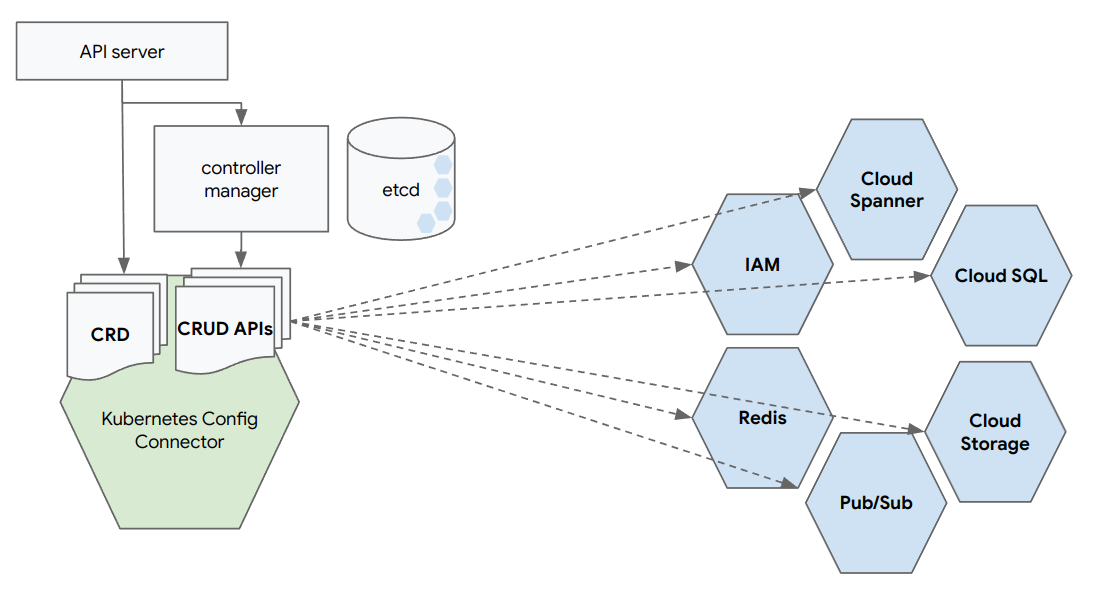Infrastructure as Code (IaC) helps "cloud native" companies manage their infrastructure based on the principles of software engineering. A wide range of IaC tools and frameworks facilitate in updating the cloud infrastructure. Config Connector is the latest member of this family and brings a new approach based on the power of Kubernetes. In this blog post we outline how it works compared to other tools.
As companies expand their infrastructure, creating and enforcing consistent configurations and security policies across a growing environment becomes difficult and creates friction. Infrastructure as Code (IaC) helps solve this by automating through code the configuration and provisioning of resources, so that human error is eliminated, time is saved, and every step is fully documented.
IaC applies software engineering practices to infrastructure and brings the same benefits to infrastructure :
- Automate: Commit, version, trace, deploy, and collaborate, just like source code.
- Declarative: Specify the desired state of infrastructure, not updates
- Roll back: Roll out and roll back changes just like a regular application
- Validate: Assess desired state vs. current state infrastructure
- Scale: Build reusable infrastructure blocks across an organization
Iac Tool landscape
Over the years there’s been an explosion in infrastructure platforms and application frameworks that form the foundation of “cloud native.” The most popular are listed in the table below.
Type Immutable Declarative Language Google Cloud Support Terraform Provisioning Yes Yes HCL Yes (*) Config Connector Provisioning Yes Yes YAML/KRM Yes Pulumi Provisioning Yes Yes JS, TS, Python, … Ansible Config mgmt YAML Chef Config mgmt Ruby (*) Support cases can be opened for Google Cloud resources managed via the Google provider.
Config Connector
Tools like Terraform and Pulumi let admins declare infrastructure in code. But code does not establish a strong contract between desired and current state, and every time code is modified or refactored, a procedural or imperative approach (think: plan/apply step) is required to revalidate the state.
Bring in Kubernetes.
Controllers are the core of Kubernetes. It’s a controller’s job to ensure that, for any given object, the actual state of the world matches the desired state in the object.
Config Connector extends the Kubernetes Resource Model with Custom Resource Definitions (CRD) for GCP services and resources.
When you install Config Connector on a Kubernetes cluster, a CRD is defined for every service and resource in GCP :
➜ kubectl get crd --namespace cnrm-system
NAME CREATED AT
accesscontextmanageraccesslevels.accesscontextmanager.cnrm.cloud.google.com 2022-11-29T07:41:51Z
accesscontextmanageraccesspolicies.accesscontextmanager.cnrm.cloud.google.com 2022-11-29T07:41:51Z
accesscontextmanagerserviceperimeters.accesscontextmanager.cnrm.cloud.google.com 2022-11-29T07:41:51Z
apigeeenvironments.apigee.cnrm.cloud.google.com 2022-11-29T07:41:51Z
apigeeorganizations.apigee.cnrm.cloud.google.com 2022-11-29T07:41:51Z
artifactregistryrepositories.artifactregistry.cnrm.cloud.google.com 2022-11-29T07:41:51Z
backendconfigs.cloud.google.com 2022-11-25T13:06:26Z
bigquerydatasets.bigquery.cnrm.cloud.google.com 2022-11-29T07:41:51Z
bigqueryjobs.bigquery.cnrm.cloud.google.com 2022-11-29T07:41:52Z
bigquerytables.bigquery.cnrm.cloud.google.com 2022-11-29T07:41:52Z
bigtableappprofiles.bigtable.cnrm.cloud.google.com 2022-11-29T07:41:52Z
bigtablegcpolicies.bigtable.cnrm.cloud.google.com 2022-11-29T07:41:52Z
bigtableinstances.bigtable.cnrm.cloud.google.com 2022-11-29T07:41:52Z
bigtabletables.bigtable.cnrm.cloud.google.com 2022-11-29T07:41:52Z
billingbudgetsbudgets.billingbudgets.cnrm.cloud.google.com 2022-11-29T07:41:52Z
binaryauthorizationattestors.binaryauthorization.cnrm.cloud.google.com 2022-11-29T07:41:52Z
binaryauthorizationpolicies.binaryauthorization.cnrm.cloud.google.com 2022-11-29T07:41:52Z
capacityrequests.internal.autoscaling.gke.io 2022-11-25T13:05:36Z
cloudbuildtriggers.cloudbuild.cnrm.cloud.google.com 2022-11-29T07:41:52Z
...
Admins can now define the desired state of the infrastructure as objects in the Kubernetes etcd database using the Config Connector CRDs. The Config Connector operator defines a controller for every CRD that will reconcile the actual state of the infrastructure with the desired state of the objects in the Kubernetes etcd database as defined by the admins.
Config Connector operator translates desired declarative state to imperative API calls.

Example
Let’s say we want to create a pubsub topic.
First we need to enable the pubsub api on our project. Based on the ServiceUsage CRD, we can create a YAML file that declares that the service is enabled :
apiVersion: serviceusage.cnrm.cloud.google.com/v1beta1
kind: Service
metadata:
name: pubsub.googleapis.com
spec:
projectRef:
external: projects/my-project-id
Store this YAML file as pubsub-service.yaml and apply it to your Kubernetes cluster:
kubectl apply -f pubsub-service.yaml
Now that the pubsub service is enabled, let’s create a topic. Based on the PubSubTopic CRD, below YAML file pubsub-topic.yaml declares a new pubsub topic :
apiVersion: pubsub.cnrm.cloud.google.com/v1beta1
kind: PubSubTopic
metadata:
annotations:
cnrm.cloud.google.com/project-id: my-project-id
labels:
managed: configconnector
name: cc-managed-topic
And apply the file again :
kubectl apply -f pubsub-topic.yaml
Head over to your GCP console and verify that a pubsub topic called cc-managed-topic is actually created. Congratulations, you have declared your configuration as data !
But now for the beauty of Kubernetes and continuous reconciliation …
Delete the pubsub topic manually from your project. The pubsubtopic-controller will detect that the actual state is no longer inline with the desired state and will start taking remediation action. Wait a couple of seconds and … Kubernetes will recreate the topic you manually deleted ! And there was no procedural/imperative step required.
Check the events on the pubsub object to verify what happened :

Conclusion
With Google Config Connector we can move to a truly declarative approach for infrastructure using Configuration as Data by harnessing the power of Kubernetes.
While Config Connector was released by Google for GCP, we see an adoption of the same principles by other Cloud providers. Microsoft Azure released Azure Service Operator and AWS is building around AWS Controllers for Kubernetes (ACK).
And then there is Crossplane that aims to bring a universal control plane to enable platform teams to assemble infrastructure from multiple vendors.
Is this the new industry trend ? Let’s see what the future brings.





